Definition, Illustration, Example, Solution - Cartesian Product | 10th Mathematics : UNIT 1 : Relation and Function
Chapter: 10th Mathematics : UNIT 1 : Relation and Function
Cartesian Product
Cartesian Product
Illustration 1
Let us consider the
following two sets.
A is the set of 3
vegetables and B is the set of 4 fruits. That is,
A = {carrot, brinjal,
ladies finger} and B = {apple, orange, grapes, strawberry} What are the
possible ways of choosing a vegetable with a fruit? (Fig.1.2)
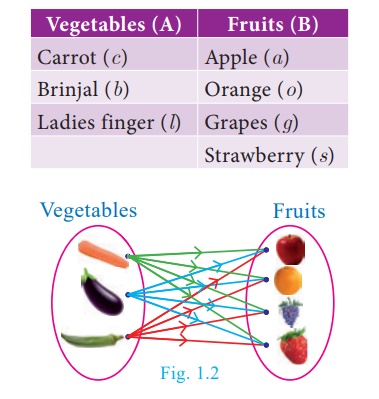
We can select them in
12 distinct pairs as given below.
(c, a),
(c, o), (c, g), (c, s), (b, a),
(b, o), (b, g), (b, s), (l, a),
(l, o), (l,g), (l, s)
This collection
represents the cartesian product of the set of vegetables and set of fruits.
Definition
If A and B are two
non-empty sets, then the set of all ordered pairs (a, b) such that a ∈ A, b ∈ B is
called the Cartesian
Product of A and B, and is denoted by A×B . Thus, A×B = {(a,b)
|a ∈ A,b ∈ B}.
Note
·
A × B is the set of all possible ordered pairs between the
elements of A and B such that the first coordinate is an element
of A and the second coordinate is an element of B.
·
B × A is the set of all possible ordered pairs between the
elements of A and B such that the first coordinate is an element
of B and the second coordinate is an element of A.
·
If a = b, then (a, b) = (b, a).
·
The “cartesian product” is also referred as “cross product”.
Illustration 2
Let A = {1, 2, 3} and B = {a, b}. Write A ×B and B ×A ?
A ×B =
{1,2,3}×{a,b} = {(1, a ),(1, b ),(2, a ),(2, b ),(3, a ),(3, b )} (as shown in Fig.1.3)
B×A
= {a,b}
× {1,2,3} = {(a,1), (a,2), (a,3),(b,1), (b,2), (b,3)} (as shown in Fig.1.3)
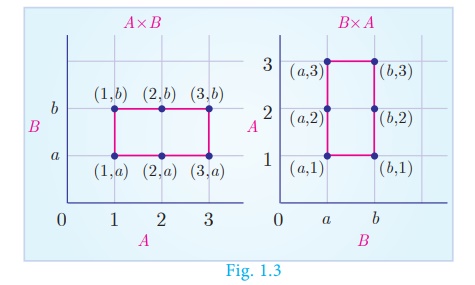
Recall of standard infinite sets
Natural Numbers N = {1, 2, 3, 4…} ;
Whole Numbers W = {0,1,2,3, ...};
Integers Z ={..., –2,–1,0,1,2,
...} ;
Rational Numbers 
Real Numbers R = Q ∪ Q’ , where Q’ is the set of all
irrational numbers.
Illustration 3
For example, let
A be the set of numbers in the interval [3, 5] and B be the set of numbers in the
interval [2,3]. Then the
Cartesian product A×B corresponds to the
rectangular region shown in the Fig. 1.4. It consists of all points (x, y) within the region
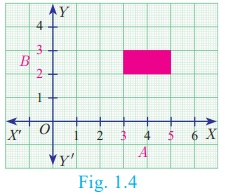
Progress check
1. For any two
non-empty sets A and B, A×B is called as ______.
2. If n(A×
B) = 20 and n(A) = 5 then n(B) is ______.
3. If A = {-1,1} and B =
{−1,1} then geometrically describe the set of points of A×B .
4. If A, B are the
line segments given by the intervals (–4, 3) and (–2, 3) respectively,
represent the cartesian product of A and B.
Note:
The set of all points
in the cartesian plane can be viewed as the set of all ordered pairs (x,
y) where x, y are real numbers. In fact, ℝ×ℝ is the set of all
points which we call as the cartesian plane.
Example 1.1 If A =
{1,3,5} and B = {2,3} then (i) find A ×B and B ×A.
(ii) Is A
× B = B ×A? If not why? (iii) Show that n(A×B) = n(B×A)
= n(A)× n(B)
Solution Given that A = {1,3,5} and B = {2,3}
(i) A×B
= {1,3,5} × {2,3} = {(1,2), (1,3), (3,2), (3,3), (5,2), (5,3)} ...(1)
B× A = {2,3} × {1,3,5} = {(2,1),
(2,3), (2,5), (3,1), (3,3), (3,5)} ...(2)
(ii) From
(1) and (2) we conclude that A × B ≠ B ×A as (1, 2) ≠ (2, 1) and (1, 3) ≠ (3, 1), etc.
(iii) n(A)=3; n (B)
= 2.
From (1)
and (2) we observe that, n (A×B) = n
(B×A) = 6;
we see
that, n (A) ×n (B) = 3 × 2 = 6 and n (B) × n (A)
= 2×3 = 6
Hence, n (A×B) =n
(B×A) = n(A) × n
(B) = 6.
Thus, n (A×B) =n
(B×A) = n(A) × n
(B).
Example 1.2 If A×B
= {(3,2), (3,4), (5,2), (5,4)} then find A and B.
Solution A×B ={(3,2), (3,4), (5,2), (5,4)}
We have A = {set of all first coordinates of
elements of A × B }. Therefore, A =
{3,5}
B = {set
of all second coordinates of elements of A ×
B }. Therefore, B = {2,4}
Thus A = {3,5} and B = {2,4}.
Example 1.3 Let A = {x ∈ N
| 1 < x <4} , B = {x ∈ W| 0 ≤ x < 2} and C = {x ∈ N |
x<3} .
Then verify that
(i) A × (B U C) = (A ×
B) U (A × C)
(ii) A × (B Ո C) = (A × B) + (A ×
C)
Solution A = {x ∈ N| 1 < x < 4} = {2, 3} , B = {x ∈W | 0 ≤ x < 2} = {0, 1},
C
= {x
∈ N | x < 3}= {1,2}
(i) A × (B ∪C) = (A
× B ) , (A × C)
B ∪
C
= {0, 1} ∪ {1, 2} = {0, 1, 2}
A × (B ∪C) = {2,
3} × {0, 1, 2} = {(2, 0), (2, 1), (2, 2), (3, 0), (3, 1), (3, 2)} ...(1)
A × B = {2, 3}
× {0, 1} = {(2,0),(2,1),(3,0),(3,1)}
A × C = {2, 3}
× {1, 2} = {(2, 1), (2, 2), (3, 1), (3, 2)}
(A × B) ∪ (A ×C) = {(2, 0), (2, 1), (3, 0), (3,
1)} , {(2, 1), (2, 2), (3, 1), (3, 2)}
= {(2, 0), (2, 1), (2, 2), (3,
0), (3, 1), (3, 2)} ...(2)
From (1) and (2), A × (B ∪C ) = (A×B ) ∪ (A×C) is verified.
(ii) A × (B ∩C) = (A ×B) ∩ (A ×C)
B Ո
C = {0, 1} ∩ {1, 2} = {1}
A × (B ∩C) = {2, 3} ×{1} = {(2,1),(3,1)} ... (3)
A × B= {2, 3} ×{0, 1} = {(2, 0),(2, 1),(3, 0),(3, 1)}
A × C = {2, 3} ×{1, 2} = {(2, 1),(2, 2),(3, 1),(3, 2)}
(A × B) ∩ (A ×C) = {(2, 0),(2, 1),(3, 0),(3, 1)}
∩ {(2, 1),(2,
2),(3, 1),(3, 2)}
=
{(2,
1),(3, 1)} ... (4)
From (3) and (4), A × (B ∩C ) = (A×B ) ∩ (A×C) is verified.
Note
The above two verified
properties are called distributive property of cartesian product over union and
intersection respectively. In fact, for any three sets A, B, C
we have
(i) A × (B ∪C) = (A ×B) ∪ (A ×C) (ii) A × (B ∩C ) = (A×B) ∩ (A×C).
Cartesian Product of three Set
If A, B,
C are three non-empty sets then the cartesian
product of three sets is the set of
all possible ordered triplets given by
A× B ×C= {(a,b,c) for
all a ∈
A,b ∈
B,c ∈
C }
Illustration for Geometrical understanding of cartesian product of two and three sets
Let A = {0,1}, B
= {0,1}, C = {0,1}
A×B = {0,1}×{0,1}
= {(0, 0),(0,1),(1, 0),(1,1)}
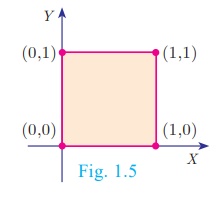
Representing A×B in the xy - plane we get a picture shown in Fig. 1.5.
(A×B)×C=
{(0, 0),(0,1),(1, 0),(1,1)} ×{0,1}
= {(0, 0, 0),(0,
0,1),(0,1, 0),(0,1,1),(1, 0, 0),(1, 0,1)(1,1, 0),(1,1,1)}
Representing A×B ×C in the xyz - plane we get a picture as shown in Fig. 1.6
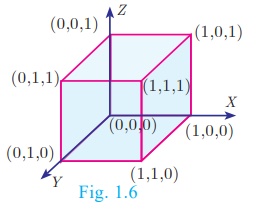
Thus, A×B
represent vertices of a square in two dimensions and A×B ×C represent
vertices of a cube in three dimensions.
NOTES
In general,
cartesian product of two non-empty sets provides a shape in two dimensions and
cartesian product of three non-empty sets provide an object in three
dimensions.
Related Topics